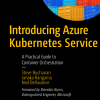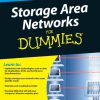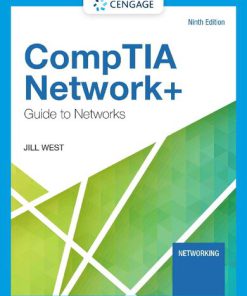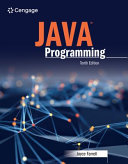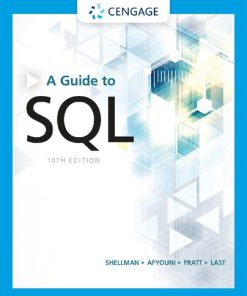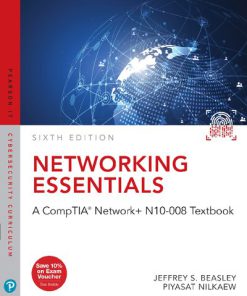Guide to Networking Essentials 8th Edition by Greg Tomsho ISBN 9780357118283 0357118286
$50.00 Original price was: $50.00.$25.00Current price is: $25.00.
Guide to Networking Essentials 8th Edition by Greg Tomsho – Ebook PDF Instant Download/Delivery: 9780357118283 ,0357118286
Full download Guide to Networking Essentials 8th Edition after payment

Product details:
ISBN 10: 0357118286
ISBN 13: 9780357118283
Author: Greg Tomsho
MindTap for Tomsho’s Guide to Networking Essentials, 8th Edition, helps you learn on your terms.
INSTANT ACCESS IN YOUR POCKET.
Study on-the-go with the Cengage Mobile App. Read or listen to textbooks, stay connected via notifications, create flashcards and take practice quizzes to stay focused and do better in class.
GEAR UP FOR ULTIMATE SUCCESS.
Track your scores, know where to focus and stay motivated toward your goals. The MindTap Green Dot will charge your confidence along the way.
MAKE YOUR TEXTBOOK YOURS.
Highlight key text, add notes and create custom flashcards. When it’s time to study, everything you’ve flagged or noted can be gathered into one organized guide.
Guide to Networking Essentials 8th Edition Table of contents:
Chapter 1. Introduction to Computer Networks
An Overview of Computer Concepts
Basic Functions of a Computer
Storage Components
Personal Computer Hardware
Computer Boot Procedure
The Fundamentals of Network Communication
Network Components
Steps of Network Communication
Layers of the Network Communication Process
How Two Computers Communicate on a LAN: Some Details
Network Terms Explained
LANs, Internetworks, WANs, and MANs
Internet, Intranet, and Extranet
Packets and Frames
Clients and Servers
Network Models
Peer-to-Peer/Workgroup Model
Server/Domain-Based Model
Chapter Summary
Key Terms
Review Questions
Packet Tracer Labs
Critical Thinking
Chapter 2. Network Hardware Essentials
Network Repeaters and Hubs
Multiport Repeaters and Hubs
Network Switches
Basic Switch Operation
Wireless Access Points
Basic AP Operation
Network Interface Cards
NIC Basics
Selecting a NIC
NIC Drivers
Wireless NICs
Routers
Routers Connect LANs
Routers Create Broadcast Domains
Routers Work with IP Addresses and Routing Tables
Chapter Summary
Key Terms
Review Questions
Packet Tracer Labs
Critical Thinking
Chapter 3. Network Topologies and Technologies
Physical Topologies
Physical Bus Topology
Physical Star Topology
Physical Ring Topology
Point-to-Point Topology
Logical Topologies
Network Technologies
Network Technologies and Media
Ethernet Networks
Ethernet Standards
Additional Ethernet Standards
802.11 Wi-Fi
Wi-Fi Modes of Operation
Wi-Fi Channels and Frequencies
Wi-Fi Antennas
Wi-Fi Access Methods and Operation
Wi-Fi Signal Characteristics
Wi-Fi Standards
Wi-Fi Security
Token Ring Networks
Fiber Distributed Data Interface Technology
Chapter Summary
Key Terms
Review Questions
Packet Tracer Labs
Critical Thinking
Chapter 4. Network Media
Wired Networking
Criteria for Choosing Network Media
Coaxial Cable
Twisted-Pair Cable
Structured Cabling: Managing and Installing a UTP Cable Plant
Fiber-Optic Cable
Fiber-Optic Connectors
Fiber-Optic Installation
Fiber-Optic Cable Types
Cable-Testing Equipment
Wireless Networking
Wireless Benefits
Types of Wireless Networks
Wireless LAN Components
Wireless LAN Transmission
LAN Media Selection Criteria
Chapter Summary
Key Terms
Review Questions
Packet Tracer Labs
Critical Thinking
Chapter 5. Network Protocols
TCP/IP’s Layered Architecture
Application-Layer Protocols
HTTP: Protocol of the World Wide Web
E-Mail Protocols: POP3, IMAP, and SMTP
FTP and TFTP
Server Message Block
Remote Desktop Protocol
Telnet and SSH
Simple Network Management Protocol
Dynamic Host Configuration Protocol
Domain Name System
Transport-Layer Protocols
Role of the Transport Layer
TCP: The Reliable Transport Layer
Internetwork-Layer Protocols
Defines and Verifies IP Addresses
Routes Packets through an Internetwork
Resolves MAC Addresses from IP Addresses
Delivers Packets Efficiently
Protocols at the Internetwork Layer
Network Access-Layer Protocols
Chapter Summary
Key Terms
Review Questions
Packet Tracer Labs
Critical Thinking
Chapter 6. IP Addressing
Ipv4 Addressing
Binary Math
Ip Address Classes
Private IP Addresses
Classless Interdomain Routing
CIDR Notation
Broadcast Domains
Subnetting
Calculating a Subnet Mask
Supernetting
Configuring IPv4 Addresses
Configuring Multiple IP Addresses
Configuring the Default Gateway
IP Configuration Command-Line Tools
Network Address Translation
Internet Protocol Version 6
IPv6 Overview
IPv6 Address Structure
IPv6 Address Types
IPv6 Unicast Addresses
Multicast Addresses
Anycast Addresses
IPv6 Autoconfiguration
Autoconfiguration on Windows Hosts
Transitioning from IPv4 to IPv6
Dual IP Layer Architecture
IPv6-over-IPv4 Tunneling
Intra-Site Automatic Tunnel Addressing Protocol
6to4 Tunneling
Teredo Tunneling
Chapter Summary
Key Terms
Review Questions
Packet Tracer Labs
Critical Thinking
Chapter 7. Network Reference Models and Standards
Introducing the OSI and IEEE 802 Networking Models
Role of a Reference Model
Structure of the OSI Model
Application Layer
Presentation Layer
Session Layer
Transport Layer
Network Layer
Data Link Layer
Physical Layer
Summary of the OSI Model
IEEE 802 Networking Standards
IEEE 802 Specifications
IEEE 802 Extensions to the OSI Reference Model
Chapter Summary
Key Terms
Review Questions
Packet Tracer Labs
Critical Thinking
Chapter 8. Network Hardware in Depth
Network Switches in Depth
Switch Port Modes of Operation
Creating the Switching Table
Frame Forwarding Methods
Advanced Switch Features
Multilayer Switches
Routers in Depth
Router Interfaces
Routing Tables
Routing Protocols
Access Control Lists
Wireless Access Points in Depth
Basic Wireless Settings
Wireless Security Options
Advanced Wireless Settings
Network Interface Cards in Depth
PC Bus Options
Advanced Features of NICs
Chapter Summary
Key Terms
Review Questions
Packet Tracer Labs
Critical Thinking
Chapter 9. Introduction to Network Security
Network Security Overview and Policies
Developing a Network Security Policy
Determining Elements of a Network Security Policy
Understanding Levels of Security
Securing Physical Access to the Network
Physical Security Best Practices
Securing Access to Network Data
Setting Up Authentication and Authorization
Securing Data with Encryption
Securing Communication with Virtual Private Networks
Securing Wireless Networks
Network Security Devices
Protecting Networks with Firewalls
Using Intrusion Detection and Prevention Systems
Protecting a Network from Malware
Viruses
Worms
Other Forms of Malware
Spyware and Spam
Malware Protection
Using an Attacker’s Tools to Stop Network Attacks
Discovering Network Resources
Gaining Access to Network Resources
Disabling Network Resources
Chapter Summary
Key Terms
Review Questions
Packet Tracer Labs
Critical Thinking
Chapter 10. Wide Area Networking and Cloud Computing
Wide Area Network Fundamentals
WAN Devices
WAN Connection Methods
Circuit-Switched WANs
Leased Lines
Packet-Switched WANs
Ethernet WANs
WANs over the Internet
WAN Equipment
Wireless WAN Technologies
Remote Access Networking
Making a VPN Connection in Windows
Making a Dial-Up Connection
Remote Access Networking via the Web
Cloud Computing
Software as a Service
Platform as a Service
Infrastructure as a Service
Private Cloud versus Public Cloud
Chapter Summary
Key Terms
Review Questions
Packet Tracer Labs
Critical Thinking
Chapter 11. Network Operating System Fundamentals
Operating System Fundamentals
The File System
Processes and Services
The Kernel
Client and Server Operating System Overview
The Role of a Client Operating System
The Role of a Server Operating System
Centralized User Account and Computer Management
Centralized Storage
Server and Network Fault Tolerance
Additional Server Features
Operating System Virtualization
Hosted Virtualization
Bare-Metal Virtualization
Installing an OS
Planning for and Installing Windows Server
Planning for and Installing Linux
Chapter Summary
Key Terms
Review Questions
Critical Thinking
Chapter 12. Network Management and Administration
Managing User and Group Accounts
Account and Password Conventions
Working with Accounts in Windows
Working with Accounts in Linux
Storage and File System Management
Volumes and Partitions
The FAT File System
The NTFS File System
The Linux File System
Working with Shared Files and Printers
Sharing Files and Printers in Windows
Sharing Files and Printers in Linux
Monitoring System Reliability and Performance
Event Viewer
Performance Monitor
Enhancing Network Performance
Network Performance Monitoring
Backup and Fault Tolerance
Windows Backup
Protecting Data with Fault Tolerance
Chapter Summary
Key Terms
Review Questions
Critical Thinking
Chapter 13. The Internet of Things (IoT)
Introduction to the Internet of Things
IoT Use Cases
IoT Technologies
IoT Networking
IoT Networking Technologies Overview
Commercial and Industrial IoT Devices
A Sampler of Home Automation IoT Devices
Industrial IoT Devices
DIY IoT
Getting Started with IoT
Tools for IoT
IoT Software Development
Chapter Summary
Key Terms
Review Questions
Packet Tracer Labs
Critical Thinking
Chapter 14. Troubleshooting and Support
Documenting Your Network
Change Management
Documentation and Troubleshooting
Documentation and IT Staffing
Documentation and Standards Compliance
Documentation and Technical Support
Documentation and Network Security
What Should Be Documented?
The Problem-Solving Process
Step 1: Determine the Problem Definition and Scope
Step 2: Gather Information
Step 3: Consider Possible Causes
Step 4: Devise a Solution
Step 5: Implement the Solution
Step 6: Test the Solution
Step 7: Document the Solution
Step 8: Devise Preventive Measures
Approaches to Network Troubleshooting
Trial and Error
Solving by Example
The Replacement Method
Step by Step with the OSI Model
Making Use of Problem-Solving Resources
Experience
The Internet
Network Documentation
Network Troubleshooting Tools
Using ping and tracert
Network Monitors
Protocol Analyzers
Time-Domain Reflectometers
Basic Cable Testers
Advanced Cable Testers
Additional Tools
Common Troubleshooting Situations
Cabling and Related Components
Power Fluctuations
Upgrades
Poor Network Performance
Disaster Recovery
Backing Up Network Data
Backup Types
Business Continuity
Chapter Summary
Key Terms
Review Questions
Critical Thinking
Appendix A. Network Troubleshooting Guide
Appendix B. MTA Exam 98-366 Objectives
People also search for Guide to Networking Essentials 8th Edition:
comptia network+ guide to networks (mindtap course list) 9th edition
guide to networking essentials
guide to networking essentials 8th edition with mindtap
guide to networking essentials 7th edition answer key
networking essentials 5th edition pdf
Tags: Greg Tomsho, Networking Essentials
You may also like…
Computers - Computer Certification & Training
CompTIA Network Guide to Networks MindTap Course List 9th Edition West Jill
Computers - Programming
Computers - Databases
A Guide to SQL MindTap Course List 10th Edition Mark Shellman
Computers - Networking
Medicine - Therapy
Business & Economics - Mathematical Economics
Computers - Enterprise Computing Systems
Relationships & Lifestyle - Sexuality
Our Sexuality (MindTap Course List) 14th Edition Robert L. Crooks

